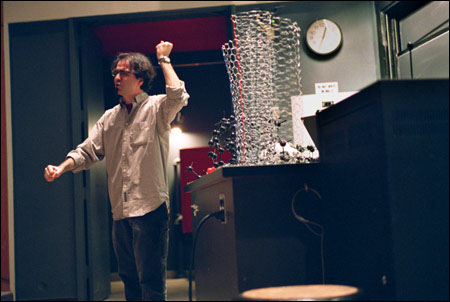TEACH Program hosts seventh-graders:
University’s TEACH program hosts area kids

The best part of Cambridge seventh-grader Vassia Vaneus’ Friday last week (April 4) was seeing all the animals and birds during a tour of the Harvard Museum of Natural History. Vaneus, who wants to be a doctor or a scientist, said she learned a lot about college Friday.
Learning about college was the reason Vaneus and more than a dozen classmates from Cambridge’s King School were on campus. They were taking part in Project TEACH, a community outreach program run by Harvard’s Office of Community Affairs.
“Ultimately, TEACH is not about Harvard, it’s about college in general, and getting kids to think about college early,” said Community Programs Administrator Paige Lewin. “TEACH dives into the details of what it’s like to be in college in order to generate excitement and help kids realize that what they do now – even in seventh grade – can affect their future.”
Project TEACH, a partnership with Cambridge Public Schools created more than 15 years ago, is offered to seventh-graders at Cambridge schools.
The day begins at Phillips Brooks House, where two current undergraduates talk for about 45 minutes on what it’s like to be at college. Brandon Gayle and Xavier Goss, both seniors, delivered the opening talk to Vaneus’ class, asking questions, defining strange words, and stressing that there are many options among the 3,200 colleges and universities in the United States. One of the day’s most important messages, though, was that despite the rising cost of college, financial aid programs ensure that cost is not a barrier for gaining a college education.
“I think [we’re] trying to get them thinking about the college process, that college is important, and though they’re in middle school, they should start thinking about it now,” Gayle said.
The day continued with a tour of the Harvard Museum of Natural History, followed by lunch at Annenberg Hall, which Lewin said is often the favorite part of the day for the students. At lunch, Lewin said, the guide shares informal details about student life – how much sleep students really get – or don’t get – what the social life is like, and things like that.
The last stop, after lunch, is a demonstration at the Science Center intended to show students that science can be fun and interesting.
“What we’re trying to get people to understand is that science is all around them and it’s in their everyday life,” said Robert Graham, assistant director of the Materials Research Science and Engineering Center at the Division of Engineering and Applied Sciences. “I think it’s important to get people to understand ongoing research to which they could one day contribute.”
The King School students saw a talk about carbon nanotubes, the ultra-tiny carbon structures that are 100 times stronger than steel yet six times lighter. With such properties, according to presenter Joel Rosenberg, an education associate at the Museum of Science, it becomes possible to build things previously thought impossible, like an elevator into space, a crash-proof car, or an earthquake-proof building.
Rosenberg described the structure of a basic carbon atom, and how that allows carbon to take very different forms, like graphite, coal, and diamond. He explained how some carbon atoms are lumped into large, 60-atom balls called, buckminsterfullerenes, also known as “buckyballs.” Carbon nanotubes are basically elongated buckyballs – some extremely elongated – which create tiny tubes made of carbon.
“It might be 150 years from now when our kids and grandkids will take the space elevator for granted like we take the regular elevator for granted,” Rosenberg said. “Before carbon nanotubes, nothing was strong enough to build something that high that wouldn’t collapse under its own weight.”
King School science teacher Jay Mahoney said he’s brought students to Project TEACH for three or four years. He said it’s a good opportunity for students who’ve probably walked through campus to actually go into the buildings and begin to imagine themselves in college, possibly at Harvard.
“It starts the process,” Mahoney said. “It’s just the beginning. It gets them thinking about what they’re going to have to do in high school [in order to go to college]. Being able to come into the buildings and museums here gives them a feeling that this is a place they might be able to achieve if they set their sights on it.”




